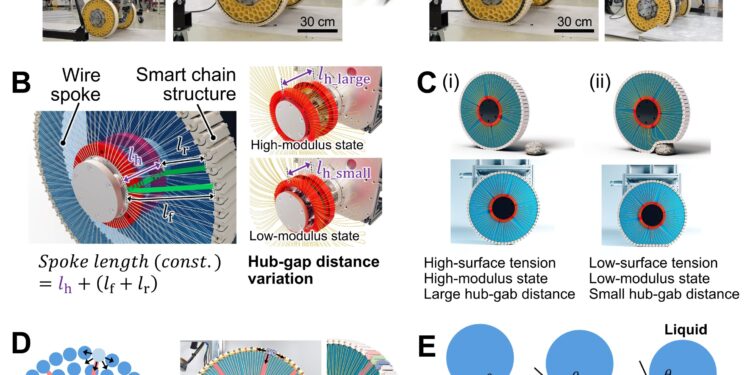Configuration of the variable stiffness deformation wheel. Credit: Sung-Hyuk Song, Korea Institute of Machinery and Materials
A team of engineers from several institutions in South Korea has developed a type of spoked wheel that can be adjusted in real time to adapt the wheel shape to uneven terrain. In their paper published in the journal Scientific roboticsThe group describes the principles behind the design of their wheels and their effectiveness in two- and four-wheel test models.
Round wheels aren’t ideal for moving over uneven terrain, including rocky outcrops and stairs. The reason they work so poorly is that they don’t adapt to the terrain you encounter. In this new effort, the research team created a wheel design that adapts and is much more effective at moving over surfaces that aren’t flat.
The researchers placed a chain of rectangular blocks around the perimeter of the wheel to act as a tread. Each of the blocks was then connected to wire spokes, the other ends of which met at an adjustable axle hub. The hub was designed with adjustable gaps between its two sides, allowing the length of the wire spokes to be changed. This allowed the chain of blocks to morph. The result is a wheel with a variable shape.
The research team showed that increasing the spacing distance results in shorter spokes, which pulls part of the chainstay (tread) inward, changing its shape to match the terrain. The wheel can also take on a round, rigid shape when traveling on flat terrain.
To demonstrate the usefulness of their design, the research team built a four-wheeled vehicle and pulled it over various obstacles. The wheel was compliant with the design, making it much easier to overcome obstacles than with a non-compliant wheel. The team also built a two-wheeled vehicle to show that it could be used to build wheelchairs for use in many more places than current designs allow.
Evaluation of wheel characteristics based on surface tension. Credit: Sung-Hyuk Song, Korea Institute of Machinery and Materials
The team suggests that their design would likely be useful for rolling robots and off-road vehicles, reducing the limitations of traditional wheel designs.
More information:
Jae-Young Lee et al, Variable stiffness deformation wheel inspired by the surface tension of a liquid droplet, Scientific robotics (2024). DOI: 10.1126/scirobotics.adl2067
© 2024 Science X Network
Quote: Watch How This Shape-Shifting Wheel Tackles Uneven Surfaces (2024, August 15) retrieved August 15, 2024 from
This document is subject to copyright. Apart from any fair dealing for the purpose of private study or research, no part may be reproduced without written permission. The content is provided for informational purposes only.



